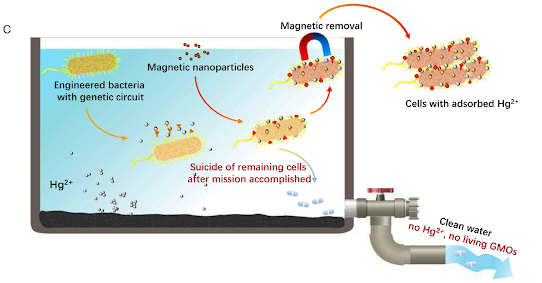Mercury traces have been found in our water and soil. This can lead to our food and water being exposed to a highly toxic heavy metal, which is a major health threat. Microorganisms can be utilized to clean up contaminants in the soil, water, and other environments. The process of bioremediation, also known as microbial remediation, can be utilized to improve our water sources and remove contaminants. It has been confirmed that this method is highly effective to dispose of contaminants, but the public is concerned regarding accidental human exposure after using a pathogen. In a study by Xue and colleagues (2022), they used a bacterium to remove mercury from the environment and found an effecive method to remove the introduced organisms. The experiment consisted of introducing a genetically modified bacteria into water contaminated with mercury. This bacteria, Pseudomonas putida, was engineered to be able to capture mercury particles. After the bacteria accomplished the removal of mercury from the water, they were magnetically removed. The results revealed that the water had no living organisms and no mercury after the treatment was completed. Considering the public concerns, the findings of this study demonstrate the biosecurity and efficiency of contaminant removal using bioremediation.
 | |||||||||||
| The figure demonstrates the process of bioremediation. Using a genetically modified organism (GMO), mercury is intended to be removed from the environment. |
Original article:
Xue, Y., Qiu, T., Sun, Z., Liu, F. and Yu, B. (2022), Mercury bioremediation by engineered Pseudomonas putida KT2440 with adaptationally optimized biosecurity circuit. Environ Microbiol, 24: 3022-3036. https://doi.org/10.1111/1462-2920.16038
No comments:
Post a Comment